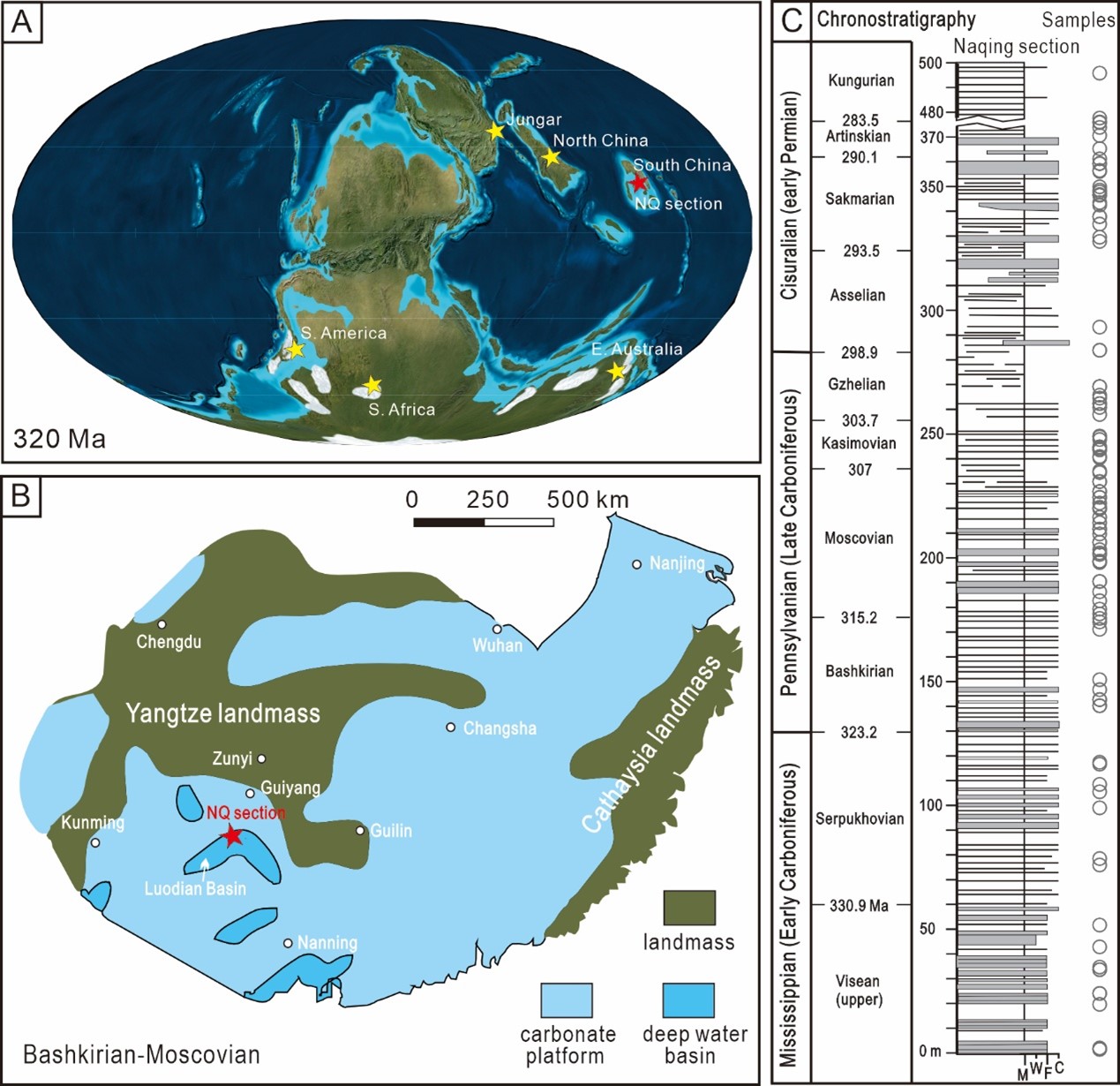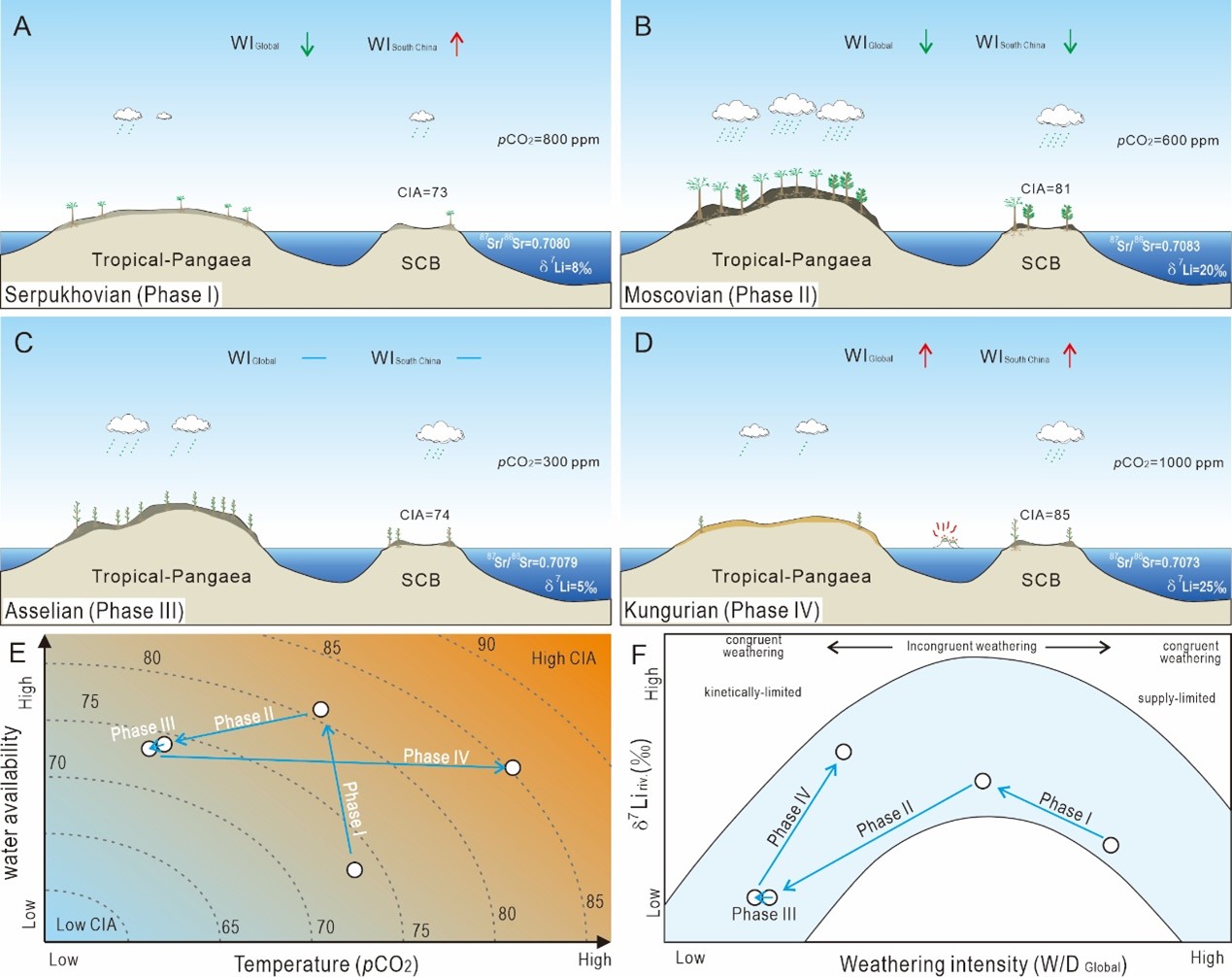Throughout most of Earth's geological history, its paleoclimate has remained hospitable to life-largely thanks to continental silicate weathering, which acts as a long-term planetary thermostat.
A research team led by Prof. CHEN Jitao from the Nanjing Institute of Geology and Palaeontology of the Chinese Academy of Sciences (NIGPAS), has developed a 60-million-year record of the Chemical Index of Alteration (CIA) from a continuously deposited Carboniferous-to-Early Permian slope sequence in South China. The study, which used geochemical and clay mineral composition analyses to measure regional chemical weathering intensity, was recently published in Geophysical Research Letters.
Silicate weathering is a critical process in Earth system evolution: it modifies atmospheric composition by absorbing greenhouse gases and delivers terrestrial nutrients to seawater-effects that alter ocean chemistry and boost marine primary productivity. For this reason, scientists have extensively studied silicate weathering across geological events to understand its role in disrupting or maintaining the Earth system's balance.
The Late Paleozoic Ice Age (LPIA) stands as the longest and most extreme "icehouse" climate event of the Phanerozoic Eon. Previous research has confirmed two key triggers for the LPIA: the low-latitude Hercynian Orogeny (mountain-building event) and the evolutionary expansion of terrestrial plants. Both processes increased continental silicate weathering fluxes, lowering atmospheric carbon dioxide (pCO2) levels. Yet distinguishing their relative contributions has proven challenging, as global weathering proxies cannot easily tell apart their shared effect of enhancing weathering fluxes.
The researchers noted a theoretical contrast between the two drivers' impacts on weathering intensity (WI). Under stable background conditions, the Hercynian Orogeny would likely reduce global average WI by accelerating physical denudation (erosion) rates-especially during cold, dry LPIA climate nadirs, where physical erosion outpaces chemical weathering. In contrast, well-developed terrestrial plant systems (e.g., extensive rainforests) would increase WI: plants speed up chemical weathering and slow denudation via their protective "shielding" effect on soil and rock.
This opposing influence creates an opportunity to disentangle the drivers' roles-particularly by comparing regional weathering records (shaped by paleoclimate and plant evolution) with global-scale data.
South China, an isolated block near the paleoequator during the LPIA, offered ideal study conditions: it remained tectonically stable, with minimal exposure to Hercynian uplift and low sensitivity to glacial-interglacial cycles. When paired with previously published seawater strontium (Sr) and lithium (Li) isotope datasets, the region's geological setting allowed the team to isolate the impacts of plant evolution and paleoclimate on weathering.
The South China CIA record revealed a four-phase pattern in regional continental weathering intensity. Phase I (333-316 Ma): Increased weathering intensity was driven primarily by the rapid expansion of paleotropical forests (likely paired with more precipitation), not by atmospheric pCO2 changes. Phases II-IV (316-275 Ma): Weathering intensity correlated strongly with atmospheric pCO2, indicating climate (rather than plants) became the dominant control.
By integrating their data with previously published 87Sr/86Sr and δ7Li records, the team also established a four-stage trajectory of global continental weathering during the Late Paleozoic. Phase I: Global weathering intensity trended opposite to South China's. This suggests Hercynian orogenic uplift drove most of the increase in global silicate weathering fluxes, with tropical forest expansion contributing secondarily. Phases II-III: Global and South China weathering intensities trended in parallel, linked by pCO2 dynamics: enhanced weathering in Phase I lowered atmospheric pCO2, triggering global cooling. Phase IV: The collapse of the Hercynian orogen reduced denudation rates in the paleotropics, weakening silicate weathering and lowering its efficiency at consuming CO2.
This study for the first time distinguishes the relative contributions of orogeny and plant evolution to silicate weathering during the Late Paleozoic Ice Age, providing key empirical evidence for research on the paleoclimate dynamics of the Earth system, the researchers noted.
The study was funded by the National Natural Science Foundation of China and the Fundamental Research Funds for NIGPAS.

(a)Global paleogeographic framework of the late Carboniferous. (b)Lithofacies paleogeographic map of South China around the Bashkirian-Moscovian stage. (c)The lithological column of the Naqing section in South China and sampling records. (Image by NIGPAS)

Evolution of continental weathering intensity during the four phases: Serpukhovian(a), Moscovian(b), Asselian(c), and Kungurian(d) stages. (Image by NIGPAS)






